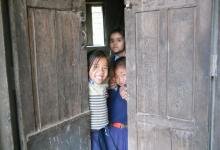Nepal's Wake-Up Call
Indian earthquake jolts Nepal.

A 6.9 magnitude earthquake on 18 September in northeastern India which also caused deaths in parts of Nepal and China, serves as a stark warning to the earthquake-prone region, experts say.
“This is a wake-up call for many, for all of those indifferent to earthquakes,” Amod Mani Dixit, executive director of Nepal’s National Society for Earthquake Technology-Nepal (NSET), told IRIN in Kathmandu.
“I am happy the earthquake took place, though I am sorry for the loss of life. I feel earthquakes are being forgotten. Now they are saying, ‘Don’t forget me’.”
Reports say dozens of people were killed in the region - including 16 in India, six in Nepal and seven in Tibet. Scores more were reportedly injured by the quake, which was felt as far away as Delhi and parts of Bangladesh. The tremor was felt across 20 districts of Nepal.
The main affected districts included Sankhuwasabha, Taplejung, Ilam, Dhankuta, Pachthar, Sunsari, Okhaldhunga in the Eastern Region, and Bhaktapur in the central region, Nepal’s National Emergency Operation Centre within the Ministry of Home Affairs reported on 19 September.
The tremor in Kathmandu, though relatively mild, brought people onto the capital's streets, 272km west of the epicentre in India's mountainous Sikkim State.
Some residents leapt from windows, a reaction experts say reinforces the need for greater preparedness - in particular what to do and what not to do before, during and after an earthquake.
“This generation has never experienced an earthquake like this before,” said Umesh Prasad Dhakal, executive director of the Nepal Red Cross Society (NRC), urging the need for increased earthquake preparedness and awareness.
Kathmandu Valley has a history of major earthquakes every 70-80 years. The last big quake (8.1 on the Richter scale) was in 1934 and killed 10,700 people. Scientists say major seismic activity is inevitable; the city has been bracing itself for “a big one” for years.
According to NSET, if an earthquake of the same magnitude that struck Haiti in January 2010 were to hit Kathmandu, some 200,000 people would die, 200,000 would be severely injured, some 1.5 million would be made homeless, and 60 percent of homes would be damaged beyond repair.
And while some experts believe the 18 September quake was a seismic energy release which could help avoid such a scenario, others warn against complacency.
“At the moment we are not very sure whether or not this will be repeated,” said Rita Dhakal, humanitarian affairs specialist with the UN Office for the Coordination of Humanitarian Affairs (OCHA). “Regardless, this is a signal for Nepal to be prepared.”
Nepal’s most recent big earthquake was 6.8 on the Richter scale in 1988 and killed 721 people.
“We were lucky this time the tremor was mild. If it was a stronger earthquake the destruction could have been massive,” the NRC’s Umesh Prasad Dhakal said.
Over 16 major earthquakes have struck Nepal since 1223, the last occurring in 1988, according to the 2009 Nepal Disaster Report by the government of Nepal and the Disaster Preparedness Network-Nepal (DPNET).
This article was first published in IRIN.

















